Welcome to the Backpacks Trailhead
Understanding Ultralight Backpacks
There is a wide variety of ultralight backpacks to choose from. Different packs are better suited to various trips, seasons, and styles of backpacking. There are specialized backpacks for thru-hiking, fastpacking, week-long trips, multi-sport trips, and more. Lightweight backpack style, volume, and material inform decisions on the rest of your gear, so choosing the right pack is integral to your backpacking experience.
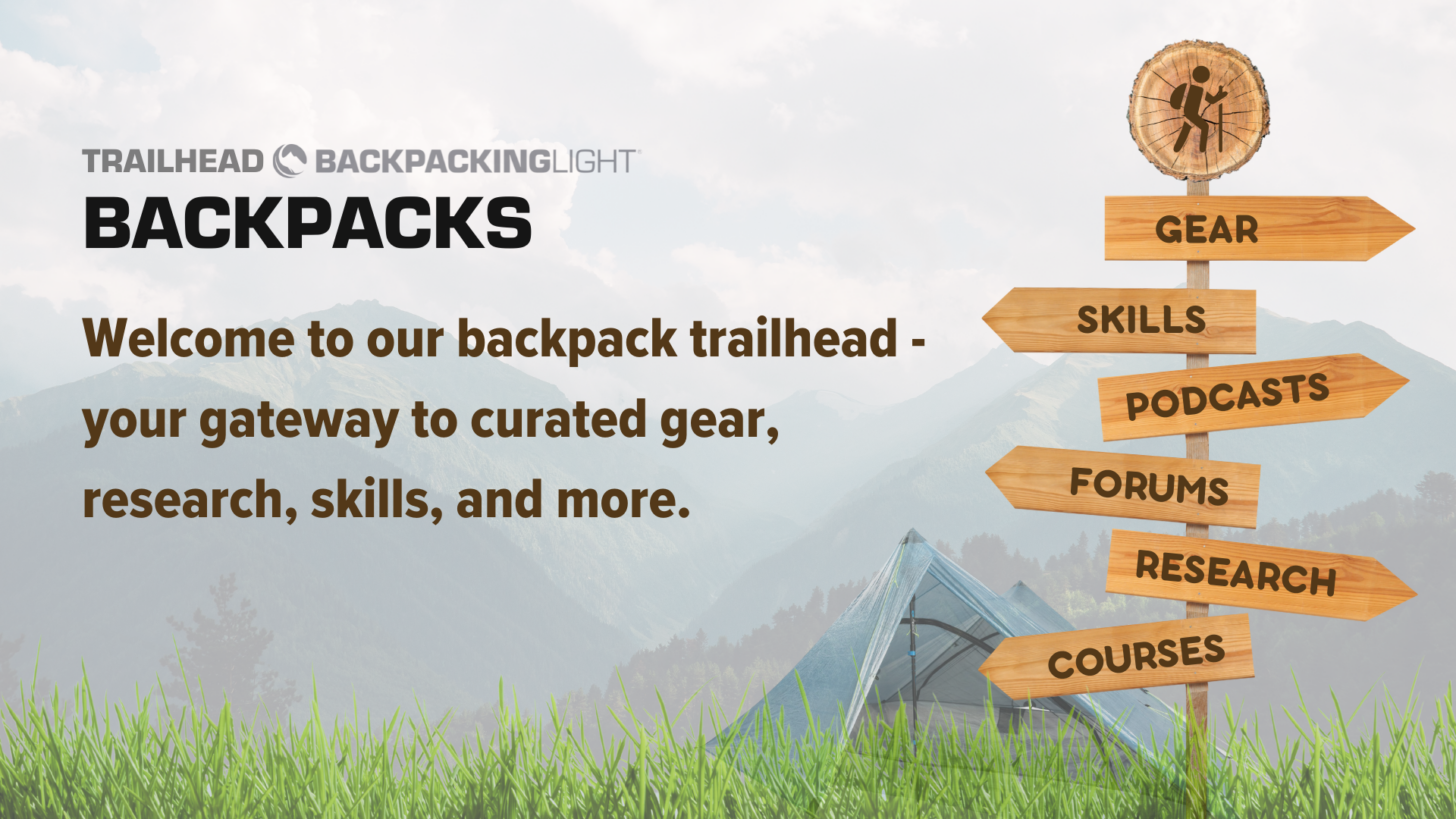
About this Trailhead
This article is one of Backpacking Light’s curated gateway pages (a trailhead, so to speak). Here, you’ll find information and resources about backpacks for ultralight backpacking. We’ve got resources for what size pack you need for ultralight backpacking, how to pack an ultralight backpack, and even how to make an ultralight backpack.
About this Trailhead: Curated and maintained by our staff, this Trailhead page includes an overview of the topic and links to information and resources at the Backpacking Light website. Those resources may consist of gear reviews, technology and testing, research, skills articles, online education (webinars, masterclasses, or other types of online courses), podcast episodes, forum threads, product recommendations, and other discovery tools, including our Gear Finder, Gear Shop, and Site Search engine.
Table of Contents • Note: some sections may only be available to Premium or Unlimited Members.
- Welcome to the Backpacks Trailhead
- What are backpacking packs?
- Do I need a lightweight backpack?
- What is a backpack for ultralight backpacking?
- Should a pack be the first thing I buy?
- Why aren’t low-volume, ultralight backpacks featured in brick-and-mortar gear shops?
- What size pack do I need for ultralight backpacking?
- How to fit a low-volume pack
- What features should I look for in an ultralight backpack?
- How do you pack a backpack?
- How to make an ultralight backpack?
- What brands are the main suppliers of lightweight and ultralight backpacks?
- What do Backpacking Light Members say about backpacks?
- More Resources
- Search and Browse: More Discovery Tools
- Help us Maintain this Page
What are backpacking packs?
What separates a backpacking pack from something you’d carry to a coffee shop or a college campus?
- Backpacking packs carry the gear needed for multi-day, self-supported travel in natural environments as efficiently and comfortably as possible. They have features designed to accommodate outdoor gear like water bottles, sleeping pads, etc.
- Pack makers construct backpacking packs of light, durable, waterproof (or all three) materials.
- Traditional backpacking packs utilize a frame structure – either an internal frame or an external frame – to distribute weight and contribute to long-term comfort.
- Ultralight backpacking packs are often (but not always) frameless but still retain outdoor-specific features like durable, lightweight materials and gear storage options.

Do I need a lightweight backpack?
Many traditional backpacking packs work best for weekend or weeklong trips and range in volume from 50 liters to 80 liters. While these packs certainly work to carry low-volume, lightweight gear, the pack’s weight (anywhere from 3 – 6 lbs / 1.3 kg – 2.7 kg) would comprise a disproportionate amount of the weight carried.
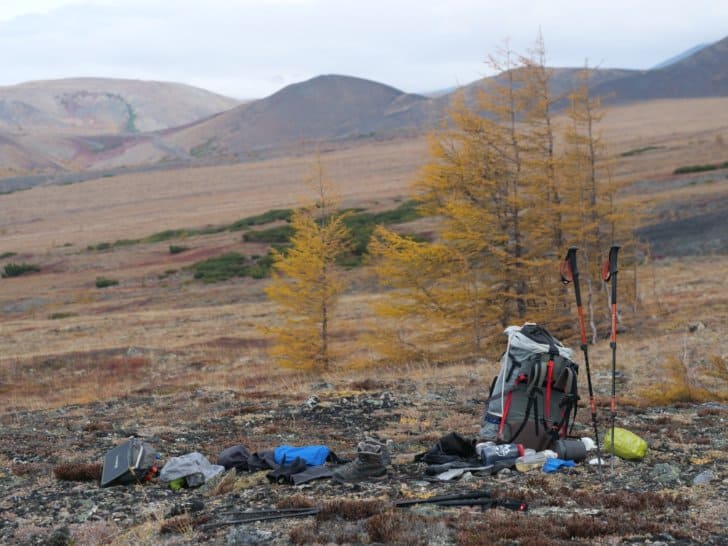
The lighter your total gear weight, the lighter a pack you can comfortably use – it’s a positive feedback loop. Having a lightweight gear kit but using a pack designed for carrying heavier loads doesn’t make much sense once you’re committed to the idea of lightweight or ultralight backpacking philosophy.
Of course, there are exceptions when needing to haul heavy loads:
- Trips: Packing Light With 95 lbs: 40 Days Without Resupply in Far Eastern Russia
- Podcast: Episode 26 | Load Hauling
What is a backpack for ultralight backpacking?
For this Trailhead, we will be focusing on backpacks designed for ultralight backpacking.
If you want some more info on ultralight backpacking philosophy, read this primer:
Ultralight packs on the market currently typically meet the following criteria:
- They have a capacity of between 35 and 65 liters.
- They have a total weight of under 2.5 lbs (1.1 kg), with most being approximately half this weight.
- They increasingly contain light, durable, waterproof materials such as Dyneema Composite Fabric (DCF), Ultra High Molecular Weight Polyethylene (commonly, Ultra), or laminated nylon (X-Pac and similar fabrics).
- They have frameless or lightweight frame designs.
- They often lack zippers, padded hip belts, internal compartments, and other standard features of traditional backpacks.
- They are often manufactured by smaller or cottage companies and often have options for customization.
Our community discusses the usability of ultralight packs in this forum thread:

Should a pack be the first thing I buy?
If you are in the early stages of assembling your backpacking kit, we recommend that a pack be one of the last items you buy. Ordering your purchases in this manner allows you to buy a pack that fits your gear. Discovering that your bear canister and your pack aren’t compatible is annoying.

Gear compatibility is less of an issue with larger volume packs (over 55 liters). Still, for persons using packs under 40 liters, it is best to have your backpacking kit assembled first. Then you can experiment with different packs to see which ones best accommodate your specific gear.
If you are a more experienced backpacker or interested in a dissenting opinion, here’s an article to check out:
- Culture: First, Buy a Smaller Pack
Why aren’t low-volume, ultralight backpacks featured in brick-and-mortar gear shops?
It is still somewhat rare to see ultralight, low-volume packs in brick-and-mortar stores. This rarity is because:
- Ultralight packs’ appeal is limited to a more niche demographic.
- They require a refined set of skills and gear often not found among folks who are just dipping their toe into backpacking.
In other words, the people using ultralight packs are usually experienced backpackers with dialed-in, specialized gear and the specialized skillsets to use that gear.
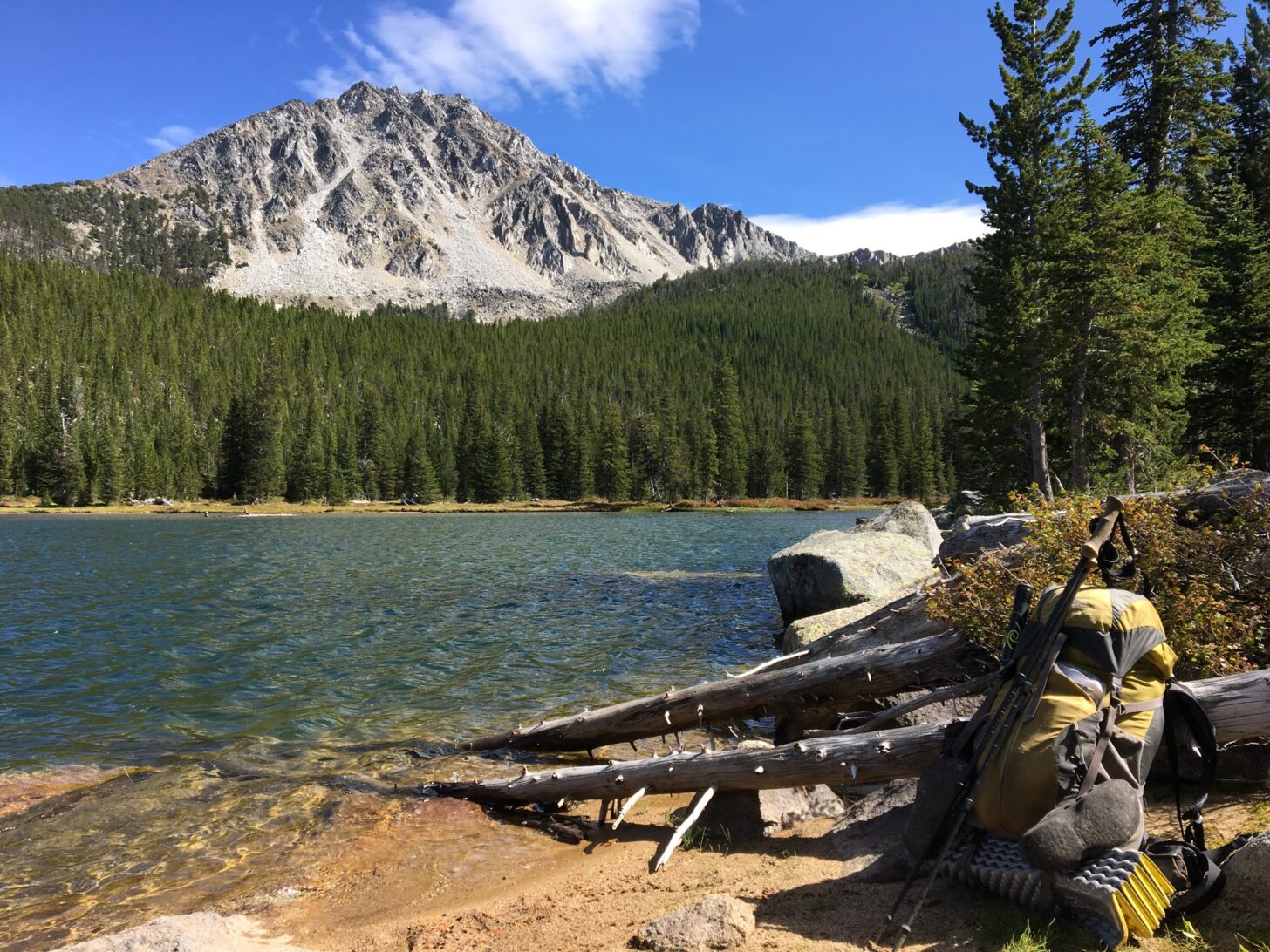
But some larger companies like REI Co-op are starting to break into the ultralight pack market. The advantage to consumers with this new development is that these packs are easy to find and try on. Here’s a review of one example:
What size pack do I need for ultralight backpacking?
Here’s what you need to consider before buying a low-volume, ultralight backpack:
- The weight of your gear.
- The weight of the food and water you are likely to carry.
- The volume of your gear + the volume of the food and water you are likely to haul.
- Your budget.
- Your most common trip types and use cases.
If your total load for a trip is usually less than 25 lbs (11.3 kg), transitioning from a traditional framed pack to a low-volume, ultralight backpack makes sense. Depending on your body type, musculature, and trip type, you might be able to make frameless packs work for loads up to 35 lbs (16 kg).

Here’s what our community has to say about pack volume:
Consumer Advocacy Warning: Be wary of listicles written by bloggers or media outlets with titles like “Best Frameless Ultralight Backpacks” because they are often little more than canned, formulaic articles (sometimes written by AI-bots or outsourced to SEO contract writers) filled with affiliate marketing links. They seldom offer performance analyses based on extensive experience in the field. We’re not going to recommend any ultralight backpack that we think is best for you. Instead, we want to give you the knowledge and skills that empower you to make the best possible decision on your own. Backpacking Light is in the business of sharing information between its members, educating consumers, and consumer advocacy – not in pushing you to buy gear. When we make a product recommendation – always consider that the product may not work for you.

The type of landscape that you most often backpack is an important consideration:
- Desert areas often require long water carries that add weight and volume.
- Alpine areas often require ice axes, crampons, or other snow or glacier travel equipment. These gear types are bulky, sharp, and need unique storage options.
- Many National Parks require food storage devices such as bear canisters or Ursacks.
- Most fabrics used in ultralight backpacks are reasonably durable. But suppose most of your trips are cross-country and involve scraping your pack against trees, shrubs, and rocks? In that case, you might be disappointed in the longevity of ultralight backpacks.
- If you’re bikepacking or packrafting, then considerations unique to those activities will play a part in your pack choice.
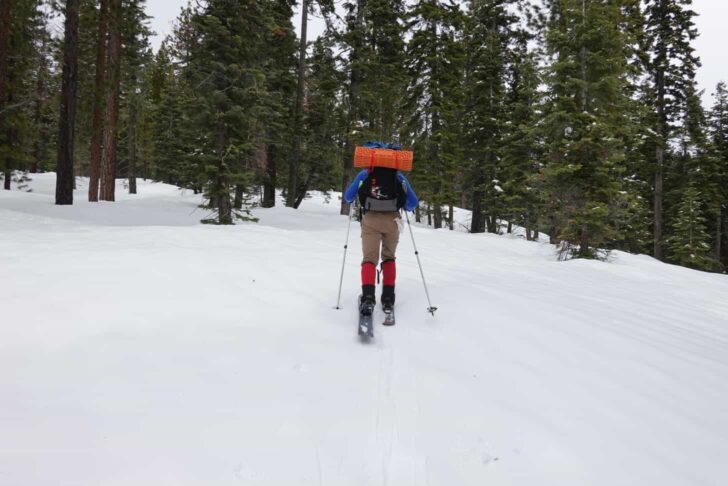
Here are some articles on specialized gear or use-cases to help you get your kit dialed in:
- Gear: Gear List: Tenkara Fly Fishing in the Northern Rockies
- Gear: Gear List: Winter Backpacking on Packed Snow Trail
- Webinar: Winter Hiking and Backpacking Gear Part 2
- Gear / Video: Lightweight Backpacking Gear for Mountain Travel (video)
- Skills: How to Use an Ursack
- Culture: How Biking to Trailheads can Enrich Backpacking
And here’s a forum thread on another specialized use case that will inform your pack choice – fastpacking:
Why use a low-volume pack?
The less volume a pack has, the lighter it tends to be, and the less gear it can fit. Less gear means less weight.
Using a low-volume backpack with an ultralight backpacking kit is an enjoyable, elegant mode of travel. It has significant appeal for people looking for an efficient and unencumbered means of moving through natural landscapes.

What volume to use?
The needed pack volume will vary between seasons and locations. Factors such as insulation or auxiliary equipment (i.e., ice ax, crampons, bear canister, etc.) come into play as well.
Most ultralight backpackers on three-season week-long trips can get by with a 40-liter pack. If you are only out for a few nights or have a low-volume kit, you can utilize an ultra-low-volume pack in the 25 – 30 L range.
People needing extra volume due to low temperatures, long water carries, or more than a week between resupply points might need a 50-60 L pack.
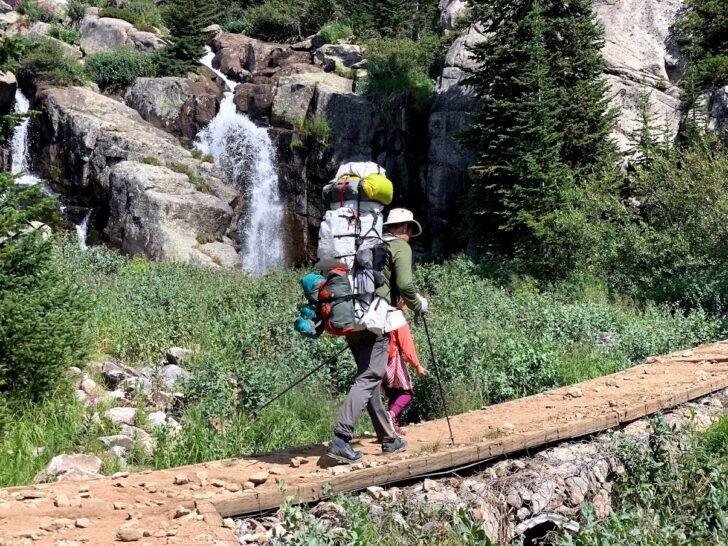
Suppose you need space in a pack for extended periods between resupply points or carrying bulky technical equipment. In that case, higher volume packs of 60 L or above might be necessary.
Here are reviews of five backpacks we’ve looked at recently. They represent a spread of volumes suitable to all the above use cases. We’ve sorted them by volume from lowest to highest:
- Gear: The Red Paw Packs 28L Flatiron (28 L)
- Gear: The LiteAF 35L Curve (35 L)
- Gear: The Hyperlight Mountain Gear Junction (55 L)
- Gear: The Gossamer Gear Mariposa (60 L)
- Gear: The Seek Outside Divide 4500 (50 – 75 L)
It’s worth taking a moment to examine how gear companies arrive at volume numbers. Generally speaking, when a company claims their pack is X volume, X refers to the total possible volume. This number includes external pockets and fully extended roll-top closures. Don’t count on getting 40 liters of gear into the primary compartment of a 40 L backpack unless a company specifically says you can. The fluidity of such standards is the subject of Rex Sanders’ Standards Watch series. He talks about backpack volume standards here:
- Testing & Research: Standards Watch: Introduction
How to fit a low-volume pack
A properly fitting pack is the most critical factor in your comfort while backpacking (other than weight). No amount of bells and whistles or super light fabrics will counteract the misery of using an ill-fitting pack. The standard measurement used to select a pack is torso length.
- Using a fabric tape measure or similar flexible measuring device, measure between the iliac crest and the C7 vertebra. The iliac crest is the top of your hip bone. The C7 vertebra is the bone that sticks out from the back of your neck when you tilt your head forward.
- This measurement is called “torso length.”
- Match your torso length to the recommended pack size on the website of your chosen pack-maker. If the pack maker doesn’t have a chart or sizing guide, email them and ask.
- Sizing up usually yields the most comfortable result when between two sizes.
- Sometimes pack makers will have additional sizing options that depend on chest and waist measurements.

What features should I look for in an ultralight backpack?
A safe generalization is this – ultralight backpacks offer fewer features than traditional backpacks. But many in the ultralight community would clarify that ultralight backpacks offer fewer needless features.

Frame or frameless?
Telemark ski bindings or AT ski bindings? Clipless cycling pedals or flats? Ford or Chevy? Statler or Waldorf? In the ultralight backpacking world, the binary question is this – framed or frameless?

A few key things to note about frameless vs. framed packs:
- Frameless packs will always be lighter than framed packs of a similar volume and fabric.
- Frameless packs can also be more convenient on trips where your mode of travel might vary (such as in packrafting or bikepacking). In cross-country travel, the lack of a frame means less chance of a rigid part of the pack getting snagged on a branch or rock.
- Internal-frame packs are more forgiving with the arrangement of items placed inside them. When using a frameless pack, you risk uncomfortable lumps poking into your back if you carelessly pack your gear. You can use a piece of closed-cell foam to create a virtual frame in frameless packs. Some packs come designed with this in mind.
- Framed packs can usually handle heavy loads better than frameless packs.
Here are some recent reviews of some of our favorite frameless packs:
- Gear: The Palante V2
- Gear: The YAR.gear Mountain Drifter 38L
- Gear: The Atom Packs Atom
Here are reviews of a few framed packs:
- Gear: The Vargo ExoTi BOG (external frame)
- Gear: The Osprey Lumina 60 (internal frame)
Hip belt or not?
A hip belt has three purposes :
- To remove shoulder strain by transferring pack load to the hips.
- To provide stability.
- To provide a location for hip belt pockets or gear storage.
There is a reduced need for hip belts in ultralight backpacking because light loads (sub 25 lb / 11 kg) put much less strain on the shoulders. For this reason, many, but certainly not all, ultralight packs lack padded hip belts. Some have minimalist unpadded hip belts to aid stability or provide pocket/gear storage space. Some ultralight packs have removable hip belts so that you can adjust your strategy as your use case changes.
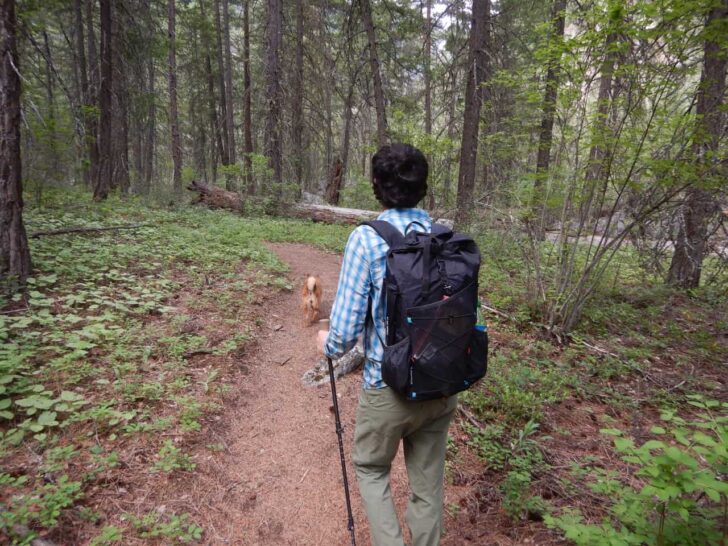
Load Lifters and Compression Straps
Load lifters are adjustable straps that run between the top of the shoulder strap and the frame (internal or external) of a framed pack. They pull the weight of a pack further or closer to one’s body, further alleviating shoulder load.
Compression straps cinch down across the sides, top, or front of a pack to create a more compact, stable load and prevent shifting within the pack. Load lifters and compression straps have less practicality on ultralight packs because you generally carry less weight.
Here’s a review of a pack that has an internal frame that interfaces with load lifters when needed but is removable for lighter loads.
- Gear: Durston DD40 Pack
Pockets and water access
Ultralight pack makers have more-or-less settled on a standard three-pocket design when it comes to the main body of the pack:
- A large vertical pocket on the rear of the pack.
- Two smaller vertical pockets on the sides of the pack.
Increasingly you may find additional pockets:
- On the shoulder straps.
- On the hip belt.
- Modularly attached to the exterior of the pack.
Some gear makers claim that their side pockets – which many hikers use for water storage – are accessible on the go without removing the pack. In practice, this is seldom the case. To reach gear in side-pockets, they must be cut and angled so that a hiker can reach around behind their torso at an awkward angle to remove the object. The more drastic the pocket angle/cut (and easier it is to reach gear), the less secure that gear is. The upshot is that vertical side pockets that are easy to reach sometimes let water bottles slide out when a hiker scrambles or bends over to tie a shoe.

The solution is to reserve side pockets for gear that you don’t need on the go and store your water somewhere else. Check out this article that explores the issue fully and provides a wide variety of solutions:
Here are reviews of two packs that do a good job of providing access to water (Hint – the trick is shoulder-strap pockets) or demonstrate modularity:
- Gear: The Mountainsmith Zerk 40L Review
- Gear: The Nashville Pack Cutaway Review
- Gear: Superior Wilderness Designs Movement 40L Backpack Review

Or read this review of the Nunatak Gear Bears Ears 50, a pack that approaches the issue in an imaginative new way.
Other external gear storage
Some gear – like ice axes or closed-cell foam sleeping pads – are too sharp or bulky to fit inside a pack’s main internal compartment or primary pockets. Many packs have daisy chains, shock cords, hook-and-loop closures, or other attachment methods to accommodate bulky or sharp gear. Look for a pack that includes external gear storage options that match your needs. Increasingly, cottage industry pack makers will be willing to work with you to modify a stock pack to match your kit.

How best to access gear while on the go is an old question.
Modular utility pouches (third-party or pack-specific) are ideal for managing small-but-crucial gear that needs to be accessed quickly. Check out this article:
How do you pack a backpack?
Developing a consistent system for packing your pack is an easy way to spend more time enjoying your backpacking trips and less time looking for misplaced items. The specifics of how you pack your backpack will vary depending on:
- The gear you have.
- The climate and weather you are in.
- Whether your pack has a frame or not (and what type of frame).
- Your habits and idiosyncrasies.
Conventional wisdom says:
- You should store the heaviest items at the bottom of your pack.
- Putting the heaviest items low in the back helps maintain the center of gravity and prevents an off-balance effect.

But a lot of gear weighs much less than when the backpacking community developed its traditional packing dogma.
The upshot is that most backpackers these days tend to pack their backpacks in ways that make the most sense when unpacking them at camp. They store items that aren’t needed during the day further down in the pack, often with food meant for later in the trip. They also store sleeping gear towards the bottom. The shelter is usually packed towards the top to allow for quick setup after arriving in camp. Items needed while on the trail (like water filters or snacks) are packed in external pockets or at the top of the pack.
As for where to put those tent poles – well – there’s a reason so many ultralight backpackers use trekking-pole supported shelters.
We talk about packing system philosophy more in this article:
And here’s a review of our favorite stuff sacks for internal organization.
How do I keep my gear dry?
Pack covers have generally fallen out of favor with lightweight and ultralight backpackers because:
- They are a pain to stop and put on.
- They are prone to leaking around the edges.
- They snag on branches and brush.
- They don’t help you much if you accidentally submerge your pack while fording.

Instead, most users incorporate a trash compactor bag or specially made pack liner into their system. Others use waterproof or water-resistant stuff sacks or compression sacks. Some people create redundant systems and use a combination of the two.
How to make an ultralight backpack?
We recommend starting here:
- MYOG: Ultralight, Ultradurable, Ultracheap: A Backpack Made from Car Airbags
- MYOG: DIY Ultralight Backpack: My Search for a Perfect Pack
- Members Blog Post: Proposal for a Novel Backpack Component: Movable Lumbar Pad
What brands are the main suppliers of lightweight and ultralight backpacks?
The list below is not comprehensive, but it does represent a good starting place. Some of these companies focus solely on lightweight backpacks, and others have various products to offer.
Since choosing a backpack with the proper fit and features for your hiking style is so use-case-dependent, it is best to cast a wide net. Look at (and more importantly, try on) several different backpacks before deciding.
Link Disclosure: The brand links below link to our brand gateway pages, which provide an index to articles, gear swap listings, and member reviews related to that brand. Likewise, all links on this page will direct to original content created by Backpacking Light. You may find affiliate links elsewhere on our site (read our disclosure letter here), but we don’t use them on this page.
- Atom Packs
- Durston Gear
- Granite Gear
- Gregory Packs
- Hyperlite Mountain Gear
- LiteAF
- Mountain Laurel Designs
- Mountainsmith
- Nashville Packs
- Osprey
- Pa’lante Packs
- REI Co-op
- Six Moon Designs
- Superior Wilderness Designs
- ULA Equipment
- Waymark Gear
- Vargo
- YAR.gear
- ZPacks
What do Backpacking Light Members say about backpacks?
These recent forum threads contain discussions about lightweight and ultralight backpacks and related topics.
- Forum: UL Backpack – Thoughts/Recommendations
- Forum: Backpack recommendation
- Forum: Choosing the right backpack
- Forum: Tests say claimed backpack volumes not even close
- Forum: Factors that influence the ability to carry weight in a backpack
More Resources
More Pack Reviews
- Gear: Durston Kakwa 40 Review
- Gear: Hyperlite Mountain Gear Junction Review
- Gear: Sea to Summit Ultra-Sil Nano Travel Day Pack Review
- Gear: Seek Outside Flight One Review
- Gear: Elemental Horizons Kalais XT Pack Review
- Gear: KS Ultralight Gear R-50 Backpack Review
- Gear: Hyperlite Mountain Gear Porter 5400 Backpack Review
- Gear: Hanchor Marble Backpack Review
- Gear: Paradox Packs Evolution Pack System Review
- Gear: Granite Gear Crown 2 60 Review
More Relevant Podcast Episodes
- Podcast: Episode 52 | Gear We Love 2021 Edition
- Podcast: Episode 31 | 40 Days Unsupported in Russia
- Podcast: Episode 24 | The Backpacking Gear We Love, and Why
- Podcast: Episode 20 | Skills Short – Backpacking With Children
Search and Browse: More Discovery Tools
- Search for Backpack Reviews in our Article Archives
- Browse the Backpacks Category in our Category Browser to find more articles, Member Gear Swap listings (classified ads for used gear), Member Gear Reviews, and more.
- Search the Forums for all forum threads about backpacks.
- Browse our curated recommendations for backpacks in the Backpacking Light Gear Shop. The Gear Shop is a product research & discovery tool to explore Member gear reviews, Gear Swap (used gear) listings, and more info about specific products recommended by our staff and members.
- Find backpacks on sale using our Gear Finder search engine.
Help us Maintain this Page
If you found value in other related resources at Backpacking Light that you’d like to share with our community, please post them in the comments section below. No external links or resources, please – there are other places in our forums appropriate for that.




Home › Forums › Lightweight and Ultralight Backpacks for Backpacking